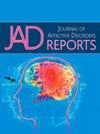Esketamine nasal spray compassionate use program in the Netherlands: An open label, multi-center cohort study in severe treatment-resistant depression
Q3 Psychology
引用次数: 0
Abstract
Background
Esketamine, a N-methyl-d-aspartate (NMDA) receptor antagonist, used intranasally (IN), is applied as an antidepressant (AD) in treatment-resistant depressed (TRD) patients. Real-world studies with IN esketamine are still scarce.
Objectives
To evaluate the effectiveness and potential moderators of response of IN esketamine in real-world TRD patients treated in a compassionate use program (CUP) in the Netherlands.
Method
In this multi-center, open label, naturalistic cohort-study 42 patients were treated with 28–84 mg IN esketamine augmenting an oral AD. We used the Montgomery-Asberg rating scale (MADRS) change scores as primary outcome and report response-, remission rates and minimal clinically important difference (MCID) reached after 28 and 90 days of treatment. Potential effect moderators studied were level of treatment resistance and history of electroconvulsive therapy (ECT).
Results
Baseline mean MADRS score was 33.6 ± 5.3 and 64.3 % of the population had a history of ≥5 failed AD treatments. At 28 days, a significant decrease of 10.1 (7.3–12.6) MADRS-points was observed (Cohen's d 1.9, 95 % CI: 0.26–0.45, t = 7.20, p < .001). Between 29 and 90 days no additional significant decrease in the MADRS score was observed. Response- and remission rates were 28.6 % and 14.3 % at 28 days and 35.7 % and 19.8 % at 90 days (n = 42), respectively. At 28 days 52.4 % achieved MCID. No clinically relevant moderating effects were found.
Limitations
Small sample size and variable time between screening and start of treatment.
Conclusions
In this group of TRD patients, IN esketamine treatment showed significant effectiveness, suggesting a valuable treatment option for this group.
艾氯胺酮鼻腔喷雾剂在荷兰的同情使用项目:一项开放标签,多中心队列研究在严重难治性抑郁症
背景埃斯氯胺酮是一种N-甲基-d-天冬氨酸(NMDA)受体拮抗剂,经鼻内注射(IN)后可作为抗抑郁药(AD)用于治疗耐药抑郁症(TRD)患者。在这项多中心、开放标签、自然科学的队列研究中,42 名患者接受了 28-84 毫克 IN esketamine 的治疗,并在此基础上口服了一种 AD。我们将蒙哥马利-阿斯伯格评定量表(MADRS)的变化评分作为主要结果,并报告治疗28天和90天后的反应率、缓解率和最小临床意义差异(MCID)。研究的潜在效应调节因素包括治疗阻力水平和电休克疗法(ECT)病史。结果MADRS的基线平均得分为33.6±5.3分,64.3%的人有≥5次AD治疗失败的病史。28 天时,MADRS 分数明显下降了 10.1 (7.3-12.6) 分(Cohen's d 1.9, 95 % CI: 0.26-0.45, t = 7.20, p <.001)。29 天至 90 天期间,MADRS 分数没有再出现显著下降。28天的应答率和缓解率分别为28.6%和14.3%,90天的应答率和缓解率分别为35.7%和19.8%(n = 42)。28天时,52.4%达到MCID。结论在这组TRD患者中,IN艾司氯胺酮治疗显示出显著疗效,表明该疗法对这组患者很有价值。
本文章由计算机程序翻译,如有差异,请以英文原文为准。
求助全文
约1分钟内获得全文
求助全文
来源期刊

Journal of Affective Disorders Reports
Psychology-Clinical Psychology
CiteScore
3.80
自引率
0.00%
发文量
137
审稿时长
134 days
 求助内容:
求助内容: 应助结果提醒方式:
应助结果提醒方式:


